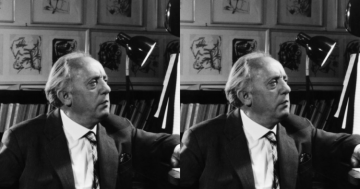Sudip Bose at The American Scholar:
 In November 1942, the German composer Karl Amadeus Hartmann traveled to Vienna from his home in Munich to spend an intense week of study with Anton Webern. The 37-year-old Hartmann was hardly a novice, but the opportunity to work with one of the masters of Viennese modernism (and a highly sought after pedagogue, at that) was too good to let pass. Hartmann could not have imagined, however, prior to his journey, just what kind of an outcast Webern had become. The Nazis had branded him a degenerate and proscribed his music, his finances were a shambles, and he was finding it increasingly difficult to compose. Indeed, with the exception of a single piece, the luminous Cantata No. 2, which he had already begun but would not complete for another year, Webern had by that point completed everything that he ever would. Upon arriving at Webern’s apartment in the suburb of Maria Enzersdorf, Hartmann discovered, much to his surprise, that he happened to be the composer’s only pupil.
In November 1942, the German composer Karl Amadeus Hartmann traveled to Vienna from his home in Munich to spend an intense week of study with Anton Webern. The 37-year-old Hartmann was hardly a novice, but the opportunity to work with one of the masters of Viennese modernism (and a highly sought after pedagogue, at that) was too good to let pass. Hartmann could not have imagined, however, prior to his journey, just what kind of an outcast Webern had become. The Nazis had branded him a degenerate and proscribed his music, his finances were a shambles, and he was finding it increasingly difficult to compose. Indeed, with the exception of a single piece, the luminous Cantata No. 2, which he had already begun but would not complete for another year, Webern had by that point completed everything that he ever would. Upon arriving at Webern’s apartment in the suburb of Maria Enzersdorf, Hartmann discovered, much to his surprise, that he happened to be the composer’s only pupil.
more here.
